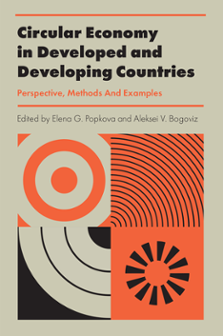
Index
Circular Economy in Developed and Developing Countries: Perspective, Methods and Examples
ISBN: 978-1-78973-982-4, eISBN: 978-1-78973-981-7
Publication date: 9 November 2020
Citation
(2020), "Index", Popkova, E.G. and Bogoviz, A.V. (Ed.) Circular Economy in Developed and Developing Countries: Perspective, Methods and Examples, Emerald Publishing Limited, Leeds, pp. 233-238. https://doi.org/10.1108/978-1-78973-981-720201032
Publisher
:Emerald Publishing Limited
Copyright © 2021 Emerald Publishing Limited
INDEX
Index
- Prelims
- Chapter 1: Criticism of the Linear Model of Economic Development and its Opposition to the Model of the Circular Economy
- Chapter 2: Principles and Priorities of the Circular Economy
- Chapter 3: The Conceptual Model of Reproduction in the Circular Economy
- Chapter 4: The Role and Value of the Circular Economy in Prevention and Overcoming of Economic Crises
- Chapter 5: Balance of Economic and Ecological Interests in the Conditions of the Circular Economy
- Chapter 6: Scientific and Methodological Approach to Systemic Analysis of the Circular Economy from the Positions of Interested Parties
- Chapter 7: Methodology of Criterial Evaluation of the Progress of Economic Systems in the Circular Economy Formation
- Chapter 8: Methodological Foundations of Measuring the Effectiveness of Implementation of the Circular Economy in the Economic Systems’ Practice
- Chapter 9: System of the Indicators for Analyzing State Managerial Initiatives in the Sphere of the Circular Economy
- Chapter 10: Ecological Standards and Their Role in Building the Circular Economy in the United States and Canada
- Chapter 11: The Culture of Responsible Production and Consumption as a Foundation of the Circular Economy in Countries of Western Europe
- Chapter 12: The Circular Economy in Industrial Countries of Asia as a Method of Reducing Ecological Costs of Economic Growth
- Chapter 13: Recycling as a Manifestation of the Circular Economy in Developing Countries
- Chapter 14: Strategic Planning of Urban Mining Material Flows as an Element of Circular Economy
- Chapter 15: Barriers on the Path of Building the Circular Economy in Modern Russia: Social Versus Financial
- Chapter 16: Successful Manifestations of the Circular Economy in Modern Russia
- Chapter 17: Creation of the Circular Economy in Russia as a Means of Acceleration Transition to the Market Path of Development
- Chapter 18: The Problem of Unequal Implementation of the Initiatives in the Sphere of Building the Circular Economy in the Modern Global Economic System
- Chapter 19: Opportunities for Overcoming the Structural Disproportions and Maximizing the Global Progress in Creation of the Circular Economy
- Chapter 20: Scenarios of Development of the Global Circular Economy: Ecological Crises Versus Economic Crises
- Chapter 21: A Perspective Algorithm of State Management of the Process of Formation and Innovative Development of the Circular Economy in Developing Countries
- Chapter 22: Reengineering of the Process of Attribution of General Shop Expenditures to Products’ Cost at a Machine-building Company
- Chapter 23: Development of Internal Corporate Control in the Conditions of Tax Monitoring
- Chapter 24: Opposition and Cooperation of Developed and Developing Countries During Formation of the Global Circular Economy
- Index